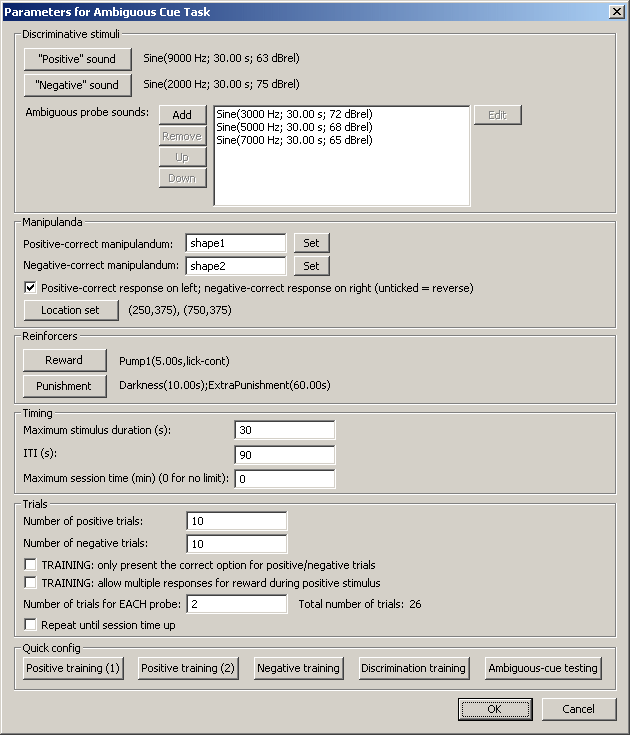Summary
| • | A "positive" tone of frequency F1 signals that responding (e.g.) left produces reward. No response, no outcome. |
| • | A "negative" tone of frequency F2 signals that responding (e.g.) right avoids punishment. No response, punishment. |
| • | Tones of intermediate frequency (between F1 and F2) are presented as probes. |
About the task
This task is currently RESTRICTED to specified laboratories.
Most distributions of MonkeyCantab do not provide it, will refuse requests to add this task, and will not load the parts of configurations that incorporate this task.
Based on Enkel et al (2012), Neuropsychopharmacology 35: 1008, doi:10.1038/npp.2009.204
Trial structure
| • | Trial begins with presentation of a positive, negative, or probe sound. One or both manipulanda are made available. |
| • | On a POSITIVE trial: during the stimulus, responding on the positive-correct manipulandum (PCM) delivers reward, terminates the stimulus, and removes the manipulanda. The ITI begins when the reward finishes. Responding on the negative-correct manipulandum (NCM) has no effect. |
| • | On a NEGATIVE trial: during the stimulus, responding on the PCM has no effect. Responding on the NCM terminates the stimulus and moves to the ITI (avoiding punishment). Otherwise, if no response on the NCM is made by the time the stimulus ends, then punishment is delivered. During punishment, responding on the NCM terminates punishment and moves to the ITI (while responding on the PCM has no effect). |
| • | On a PROBE trial, responding on either the PCM or the NCM terminates the stimulus and moves to the ITI. If the stimulus ends with no response, the ITI begins. |
| • | If they have not already gone, the manipulanda disappear at the start of the ITI. |
Configuring the task

The options are as follows:
DISCRIMINATIVE STIMULI
| • | Positive sound. The signal that responding on the positive-correct manipulandum (PCM) will deliver reward. |
| • | Negative sound. The signal that responding on the negative-correct manipulandum (NCM) will avoid or escape punishment. |
| • | Ambiguous probe sounds. Unreinforced signals, intended to be intermediate in frequency and equal in subjective loudness to the positive and negative sounds, to test the generalization gradient. |
| • | NOTE that the DURATIONS specified for each sound are overridden; the sounds are played on loop for as long as the task requires. |
MANIPULANDA
| • | Positive-correct manipulandum (PCM). The visual stimulus used as the PCM. |
| • | Negative-correct manipulandum (NCM). The visual stimulus used as the NCM. |
| • | Positive-correct response on left...? For counterbalancing. If you choose unusual locations on the screen, "left" here means the first of the two locations specified; "right" means the second. |
| • | Location set. Specify two locations used for the manipulanda. |
REINFORCERS
| • | Reward. Set the parameters for reward. |
| • | Punishment. Set the parameters for punishment. |
TIMING
| • | Maximum stimulus duration (s): How long should the stimuli be played for, in the absence of a consequential response (or, with the training option that allows multiple responses for reward during the positive stimulus, even in the presence of a response)? |
| • | ITI (s): Specify the intertrial interval. |
| • | Maximum session time (min) (0 for no limit): Specify the maximum session time, or specify 0 for no limit (in which case the task proceeds until the allotted number of trials have been completed). Trials won't be interrupted halfway through if the session time expires; instead, the task will then finish when the current trial finishes. |
TRIALS
| • | Number of positive trials. Specify the number of positive trials to deliver. |
| • | Number of negative trials. Specify the number of negative trials to deliver. |
| • | TRAINING: only present the correct option for positive/negative trials. By default, both manipulanda (PCM and NCM) are presented for all trials. As a training option, you can present only the correct manipulandum (not applicable to probe trials -- though these aren't usually given during training!). |
| • | TRAINING: allow multiple responses for reward during positive stimulus. By default, a response to the PCM during a positive trial terminates the trial. This option keeps positive trials running until the maximum stimulus duration has elapsed, during which time rewards are delivered on a fixed-ratio-1 schedule on the PCM. |
| • | Number of trials for EACH probe. Specify the number of probe trials given for EACH probe in the list of probes. |
| • | The actual trials are created as a block (e.g. 10 positive, 10 negative, 2 per probe, 3 probes = 26 trials) and then the block is shuffled. |
| • | Repeat until session time up? If you tick this option, then when the block of trials is complete, another is generated and delivered, until the session time expires. |
QUICK CONFIG
Some quick defaults:
| • | Positive training (1). Delivers positive trials only for 30 minutes. Presents only the PCM. Allows FR1 responding for reward during each 30-second positive stimulus. ITI is 30 seconds. |
| • | Positive training (2). Delivers positive trials only for 30 minutes. Presents only the PCM. Responding on the PCM terminates the trial. Stimulus is 30 seconds otherwise. ITI is 90 seconds. |
| • | Negative training. Delivers 20 negative trials. Presents only the NCM. Responding on the NCM terminates the trial, avoiding or escaping punishment. Stimulus is 30 seconds before delivery of punishment. ITI is 90 seconds. |
| • | Discrimination training. Delivers 10 positive and 10 negative trials, with both manipulanda on offer, with settings as the previous two phases. |
| • | Ambiguous-cue testing. Delivers 10 positive trials, 10 negative trials, and 2 of each kind of probe. |